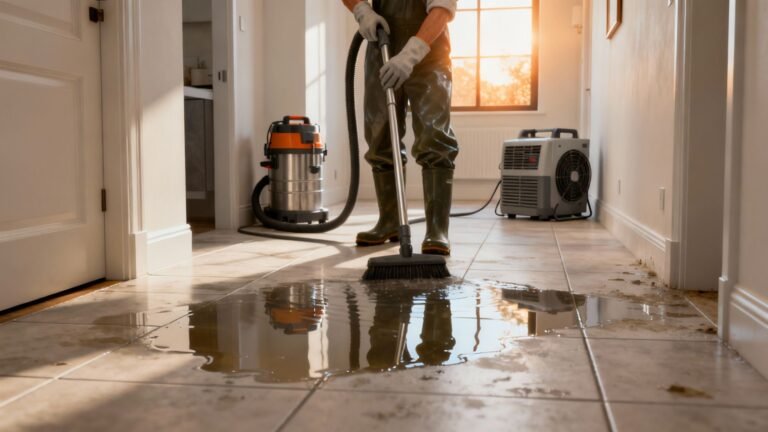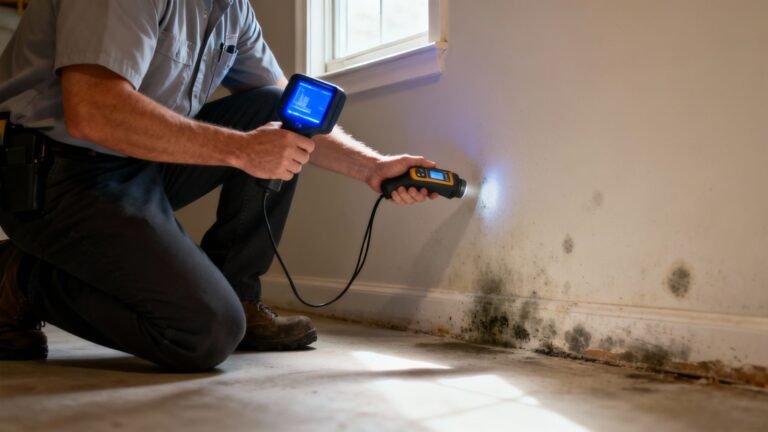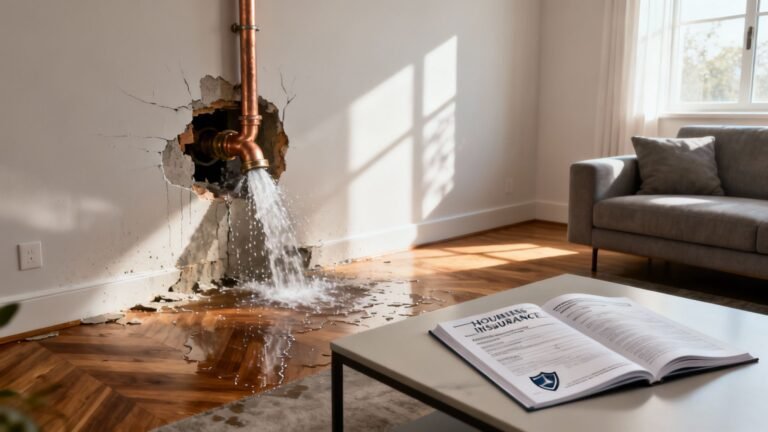
Your Guide to Emergency Water Cleanup at Home
When you find yourself standing in water inside your home, the clock starts ticking. Those first 30 minutes are absolutely
If you’re asking how often should air quality testing be done, here’s the short answer: healthy homes need a light annual checkup, higher-risk buildings should be checked two to four times a year, and any water damage or mold remediation project should finish with targeted testing to verify the fix. Your exact cadence depends on risk factors like moisture history, building age, HVAC design, occupant sensitivity, and local conditions such as wildfire smoke.
Below is a clear schedule you can follow, plus what to test, when DIY monitors are fine, and when professional sampling is worth it.
Healthy single-family home with no issues: basic check yearly; HVAC service twice yearly with filter change.
Condos/apartments with shared walls or central systems: screening every 6–12 months.
Homes with infants, seniors, or asthma/allergy: screening every 3–6 months or at the season change.
After any leak, overflow, or roof/deck intrusion: immediately inspect and moisture-map; do post-drying verification before closing walls.
After mold remediation: post-remediation verification (PRV) by an independent assessor when the scope is significant or an HOA requires it.
During wildfire season or poor outdoor air episodes: continuous PM2.5 watch via monitor; formal test if symptoms persist 1–2 weeks after outdoor air improves.
Offices, clinics, classrooms: screening quarterly; full assessment annually or after renovations.
Before buying or selling a property with past moisture claims: targeted IAQ screening during due diligence.
Air quality isn’t one test. Choose methods that answer a specific question.
Screening tools (good for routine checks):
PM2.5/PM10 monitors to track fine particles (dust, smoke).
CO₂ monitors as a ventilation proxy in occupied rooms.
CO alarms and combustion safety checks near gas appliances.
Humidity and temperature loggers; sustained RH > 60% raises risk.
Moisture meters/thermal imaging after any leak or stain.
Targeted sampling (use when results change actions):
Mold air or surface sampling to support PRV or answer a dispute.
VOC/formaldehyde sampling after new cabinets, flooring, or a strong odor complaint.
Asbestos/lead testing before disturbing suspect materials (compliance driven).
Rule of thumb: Measure when the result will change your scope, timeline, or clearance. If the cause is obvious (a fresh leak) and you’re already opening and drying the assembly, sampling can be unnecessary until the end for verification.
Frequency: annual screening. Checklist: replace filters (MERV 11–13 if system allows), verify bathroom and laundry exhaust to exterior, confirm indoor RH ~40–50%, do a room-by-room CO₂ spot check during typical occupancy. When to add testing: after a storm event, a plumbing mishap, or if musty odors appear.
Shared walls, stacked plumbing chases, and central ventilation can move problems sideways. Frequency: every 6–12 months; PRV after any unit-to-unit water event. Focus: moisture mapping near shared chases, PM2.5/CO₂ in bedrooms and living areas, odor investigation along corridors. Documentation: unit-specific logs help managers and insurers.
Frequency: every 3–6 months or at season changes. Focus: PM2.5 trends, CO₂/ventilation in sleeping rooms, humidity control, and quick moisture checks after small spills or bath/kitchen events. Action threshold: if PM2.5 spikes or CO₂ stays high during typical use, adjust ventilation/filtration and retest within 2–4 weeks.
Frequency: twice yearly for the first year after renovation, then yearly. Focus: VOC/formaldehyde screening from new finishes, confirm exhaust fans vent outdoors, and verify under-sink and supply-line fittings after move-in.
Frequency: quarterly screening plus an annual full assessment. Focus: ventilation balance (CO₂ during occupancy), filter condition, PM2.5 in high-traffic zones, humidity control, and water-intrusion patrol around roofs and mechanical rooms. Events that trigger extra testing: roof leaks, tenant improvements, or odor complaints that persist >72 hours.
Water drives the majority of indoor air problems. The sequence matters more than the sample count.
Immediate response: stop the source, make safe, and map moisture with meters and thermal imaging.
Dry to target: run a closed drying system until framing and assemblies hit objective moisture goals.
Decide on sampling:
Not always needed for small, well-documented, non-porous incidents that dried quickly.
Recommended when porous materials were colonized, the scope was large, an HOA or insurer requires proof, or a sensitive occupant is involved.
Post-drying verification or PRV: visual cleanliness, no odor, and normal moisture readings. A third-party assessor may collect air or surface samples depending on the project and local policy.
Bottom line: test after control and dry-down to prove success, not before you’ve corrected the cause.
DIY is enough when you want ongoing awareness and quick feedback:
Place PM2.5 and CO₂ monitors where you live and sleep.
Log RH and temperature.
Change filters on schedule and inspect for leaks monthly.
Hire a professional when:
You have an active or recent water event.
A musty odor persists despite cleaning and normal RH.
There are health complaints linked to a room or time of day.
An HOA, buyer, school board, or insurer requires PRV or a stamped report.
You need moisture mapping, thermal imaging, or cavity access without over-demo.
A good report explains cause → extent → actions → results, not just lab numbers. It should tell you what to fix, not only what’s “high.”
For many West Coast cities, wildfire smoke is the biggest seasonal driver of indoor air quality.
During smoke days: keep windows closed, run central air on recirculate with the highest MERV your system supports, use portable HEPA units, and watch PM2.5 on a room monitor.
Testing frequency: rely on continuous PM2.5 monitoring throughout the season. If irritation persists 1–2 weeks after outdoor air improves, consider a targeted assessment for infiltration paths and filtration performance.
After the season: do a post-season check of PM2.5, replace filters, and clean or replace pre-filters on HEPA units.
PM2.5: as low as practical indoors, typically <12 µg/m³ on average during clean outdoor conditions.
CO₂: close to outdoor baseline in empty rooms; during typical occupancy aim to keep it <1000 ppm (lower is better).
RH: 40–50% is a good target in most climates; avoid sustained >60%.
Odor: none after cleanup and dry-down.
Moisture: framing and subfloors at or near baseline for your material and region.
Numbers vary by building and climate, but these targets guide decisions. Track trends, not one-off spikes.
Quarter 1:
Replace HVAC filters; clean supply/return grilles.
CO₂ spot checks during evening occupancy.
RH calibration and a quick leak patrol (under sinks, around windows).
Quarter 2:
PM2.5 trend review; clean or replace pre-filters on portable HEPA units.
Inspect bathroom and laundry exhaust; confirm discharge to exterior.
Check irrigation set-backs from stucco and soil height at the weep screed.
Quarter 3 (wildfire season prep):
Upgrade to the highest MERV filter your system supports.
Place HEPA units in bedrooms and main living areas.
Seal obvious infiltration paths (attic access, door sweeps).
Quarter 4:
Whole-home screening: PM2.5, CO₂, and RH review; moisture spot checks near kitchens, baths, and exterior walls.
Schedule full HVAC service.
If a leak or odor appears at any time, pause the schedule and shift to the water-event sequence above.
Sampling before fixing moisture. You’ll measure a problem you already know exists. Fix first, then verify.
Fogging instead of source removal. Odor may drop temporarily while the cause persists.
Ignoring ventilation. High CO₂ means stale air; you’ll misread odors and VOCs if you don’t address ventilation.
Chasing a single bad reading. Look at trends across time and rooms.
Using the wrong test for the question. Choose methods that change your next step.
Intent match: answers the exact question “how often should air quality testing be done” in the first screen.
Depth: gives a full schedule by building type and risk level.
Actionable: tells readers what tests to use and when PRV is appropriate.
Local relevance: addresses wildfire season and multi-unit logistics that matter in West Coast cities.
E-E-A-T signals: clear process, risk-based cadence, and conservative testing guidance consistent with industry standards.
Call if you have a new leak, a recurring musty odor, persistent symptoms in a single room, or if an HOA/insurer requires PRV. You’ll get moisture mapping, a remediation plan if needed, and a report that shows cause → extent → actions → results in a format decision-makers accept.
Need help now? Call (818) 336-1800 for an assessment or post-remediation verification.

Pete Mantizian is the dedicated owner of Onsite Pro Restoration. He is driven by a passion to improve living conditions and prevent health issues caused by improper restoration. With over 10 years in construction and 7 years in restoration, Petros has managed projects for major franchises like Serv-Pro and 911 Restoration. He holds certifications in Applied Structural Drying, Microbial Remediation, and more. Committed to excellence, Petros ensures every project is done right the first time. Outside of work, he cherishes time with his loving wife and two children, balancing his fulfilling career with creating lasting family memories.
Share
Concerned about the air your family is breathing? Call (818) 336-1800, email info@onsitepro.org, or complete the form below to schedule professional air testing. Our certified team will identify hidden pollutants and provide solutions to keep your home healthy.

When you find yourself standing in water inside your home, the clock starts ticking. Those first 30 minutes are absolutely

That musty smell in your basement you can't quite place, or that dark spot spreading on the ceiling after a

Wondering if homeowners insurance covers burst pipes in California? This guide explains when water damage is covered, what exclusions apply,